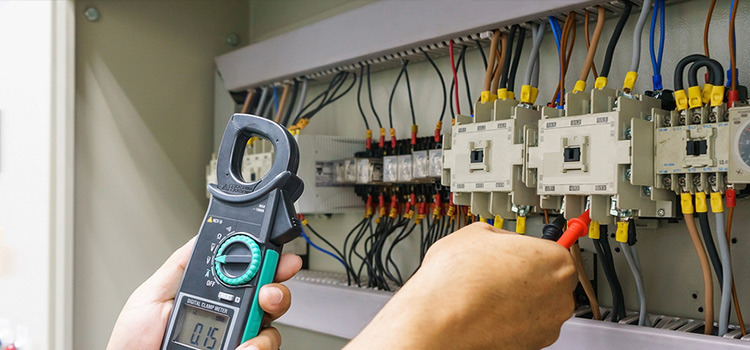How To Determine Line Vs Load Wires
To decide line and load wires, you have to find the black and ruddy wires. In nearly cases, black tin can be the line wire and the red wire is the load. Considering various nations use different colors, information technology might exist difficult to distinguish between the line and load wire colors in an electrical excursion.
The quickest approach to determine the line/hot and load wires is to look at the insulation colors. There are, all the same, methods for recognizing the wires in the house.

How to Determine Line and Load Wires?
The majority of electric cables are insulated to protect consumers from electric stupor. Each color on the electric wire has a purpose but may be used interchangeably. The colors include blackness, red, yellow, grayness, blank copper, brown, blue, white, and light-green with yellow stripes.
Determine Line/Load Wires by Color
White and grey wires are neutral. Greenish with yellow stripes, green and copper wires are ground wires. Black might be the line/upstream cable or load/downstream wire. And red or blackness are load/downstream wires. Travelers are either white or black.
By learning the colors used in your nation, you'll be able to tell which is line wire/hot and which is load wire. Different nations use different color codes for wiring.
Decide Line/Load Wires past Its Position
Line/incoming wires are e'er attached from the bottom to the electrical panel, whereas load cables are connected from the height. Yous can tell the deviation between the line and load wires in the electrical panel by looking at the position of the connected wire on the panel box.
Wires on the panel box tin help you a lot, and if y'all can't find them, get help from a friend or an experienced electrician who will be able to help you handle the problem securely.
Determine Line/Load Wires by Voltage Tester
Volt stick/pen measures voltage without touching blank copper wire; employ a voltage pen to test every wire linked to the switch. Consider other persons in the house when testing each line, and never leave bare wires unsecured in whatsoever example.
If the pen tester lights red, the wire is line wire; if the pen does not wink at all, the wire is load wire. A volt stick is a useful tool for checking the electric current-carrying wire without having to undo the cable'southward connection to the meter box.
Determine Line/Load Wires past Digital Multimeter
A multimeter is a device that measures the electrical values, voltages, resistance, and current in an electrical circuit. To identify the line wire and load wire in your meter or socket, turn your multimeter knob to Air conditioning voltage and read 200 volts. The blackness probe reads COM, while the red probe points to V. (voltage).
Connect the multimeter'south insulated terminals to the terminals of wires connected to the switch. If it displays 120 volts or above, it is the line and load wire in your meter box or switches. Using a multimeter appropriately tin can alleviate the problem of recognizing the line wires and load wires, which might be difficult to identify.
How to Differentiate Betwixt Line and Load Wires
A line is a wire that connects a current source to a switch. Information technology is located upstream of the switched device. The line is constantly hot. On the other hand, load is the wire that connects the switch to the device. If the switch is closed, the load will exist hot.
Consider a spigot and hose. The pipe exiting the home, like the line wire, is always under pressure. The spigot serves equally the switch, while the hose serves as the load. When y'all turn the handle, yous get water force per unit area (voltage) in the hose, merely when you turn the handle off, the hose stops transporting water.
Precautions
When dealing with electricity, avoid working on moisture floor. Wear shoes with rubber soles since they conduct zero electricity. Metal ladders should be avoided since they conduct electricity well. Condom-insulated tools are e'er the best to utilise. Also, brand certain non to overload the electric outlet.
Use only approved and recommended light bulbs, wiring, and equipment. Never work with exposed electric lines. While working, avert dangling cables over your head. You should know virtually electrical repairing; if you are not trained as an electrician, seek the services of a certified electrician.
If Line and Load Go Mixed Upwardly
A ground error (radio in the tub) will not trip the GFCI (Ground-Error Excursion Interrupters) if the load and line wiring are mixed up. This occurs when the hot and neutral wires are reversed at an outlet or upstream from an outlet. Reversed polarity can provide a shock risk, although information technology's typically a uncomplicated fix.
Is the line a load or common?
Remember that one side of the three-way common is the line side and the other is the load side or switch leg. Carriers are the ii wires that link the iii-way switches.
Conclusion
Color code is usually not the about effective style to decide the line and load wires. It is recommended to follow the other methods. Also, make sure to obey the safety precautions before you get involved in these types of operations.
Source: https://www.circuitsgallery.com/how-to-determine-line-and-load-wires/

0 Response to "How To Determine Line Vs Load Wires"
Post a Comment